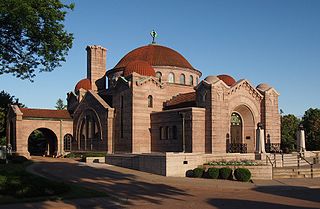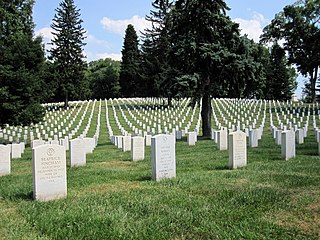
A cemetery, burial ground, gravesite or graveyard is a place where the remains of dead people are buried or otherwise interred. The word cemetery implies that the land is specifically designated as a burial ground and originally applied to the Roman catacombs. The term graveyard is often used interchangeably with cemetery, but a graveyard primarily refers to a burial ground within a churchyard.

Old Chapel Hill Cemetery is a graveyard and national historic district located on the campus of the University of North Carolina at Chapel Hill in Chapel Hill, North Carolina.

Oakland Cemetery is one of the largest cemetery green spaces, in Atlanta, Georgia, U.S. Founded as Atlanta Cemetery in 1850 on six acres (2.4 hectares) of land southeast of the city, it was renamed in 1872 to reflect the large number of oak and magnolia trees growing in the area. By that time, the city had grown and the cemetery had enlarged correspondingly to the current 48 acres (190,000 m2). Since then, Atlanta has continued to expand so that the cemetery is now located in the center of the city. Oakland is an excellent example of a Victorian-style cemetery, and reflects the "garden cemetery" movement started and exemplified by Mount Auburn Cemetery in Massachusetts.

Lakewood Cemetery is a large private, non-sectarian cemetery located in Minneapolis, Minnesota, United States. It is located at 3600 Hennepin Avenue at the southern end of the Uptown area. It is noted for its chapel which is on the National Register of Historic Places and was modeled after the Hagia Sophia in Istanbul, Turkey.

Chalmette National Cemetery is a United States National Cemetery located within Jean Lafitte National Historical Park and Preserve in Chalmette, Louisiana. The cemetery is a 17.5-acre (7.1 ha) graveyard adjacent to the site that was once the battleground of the Battle of New Orleans, which took place at the end of the War of 1812. Despite its proximity to the site of the Battle of New Orleans in the War of 1812, the majority of the interments are of soldiers who were casualties or veterans of the American Civil War, the Spanish-American War, World War I, World War II, the Korean War, or the Vietnam War. The cemetery was subsequently closed to new interments.

Salem Street Burying Ground is a cemetery located at the intersection of Salem Street and Riverside Avenue in Medford, Massachusetts. The Salem Street Burying Ground was used exclusively from the late 17th century to the late 19th century for the burial of the town's wealthy. The cemetery was listed on the National Register of Historic Places in 1981.

Culpeper National Cemetery is a United States National Cemetery located in the town of Culpeper, in Culpeper County, Virginia. Administered by the United States Department of Veterans Affairs, it encompasses 29.6 acres (120,000 m2) of land, and as 2021, had over 14,000 interments.

Camp Nelson National Cemetery is a United States National Cemetery located in southern Jessamine County, Kentucky. It was originally a graveyard associated with the U.S. Army's Camp Nelson, which was active during the U.S. Civil War and its aftermath. The camp was named for Major General William "Bull" Nelson, commander of the Civil War Army of Kentucky, who was murdered by a fellow officer in 1862.

Maple Hill Cemetery is the oldest and largest cemetery in Huntsville, Alabama. Founded on two acres in about the year 1822, it now encompasses nearly 100 acres and contains over 80,000 burials. It was added to the Alabama Historical Commission's Historic Cemetery Register in 2008, and to the National Register of Historic Places in 2012. Its occupants include five governors of Alabama, five United States senators, and numerous other figures of local, state, and national note. It is located east of the Twickenham Historic District.

Crown Hill National Cemetery is a U.S. National Cemetery located in Indianapolis, Marion County, Indiana. It was established in 1866 on Section 10 within Crown Hill Cemetery, a privately owned cemetery on the city's northwest side. Administered by the United States Department of Veterans Affairs, the National Cemetery encompasses 1.4 acres (0.57 ha) and serves as a burial site for Union soldiers who fought in the American Civil War.

Fort Snelling National Cemetery is a United States National Cemetery located in the Fort Snelling Unorganized Territory adjacent to the historic fort and Minneapolis–Saint Paul International Airport. It is one of the two national cemeteries in the state and is the older. Administered by the United States Department of Veterans Affairs, it covers 436.3 acres (176.6 ha), and as of 2021 had over 246,000 interments. It was listed on the National Register of Historic Places in 2016.

St Pancras and Islington Cemetery is a cemetery in East Finchley, North London. Although it is situated in the London Borough of Barnet, it is run as two cemeteries, owned by two other London Boroughs, Camden and Islington. The fence along the boundary which runs west to east between the two parts of the cemetery has been removed, although the line of it is still marked.

The Miami City Cemetery is a historic cemetery in Miami, Florida, United States. It is located at 1800 Northeast 2nd Avenue. On January 4, 1989, it was added to the U.S. National Register of Historic Places.

Lone Fir Cemetery in the southeast section of Portland, Oregon, United States is a cemetery owned and maintained by Metro, a regional government entity. Listed on the National Register of Historic Places, the first burial was in 1846 with the cemetery established in 1855. Lone Fir has over 25,000 burials spread over more than 30 acres (120,000 m2).

Southern Cemetery is a large municipal cemetery in Chorlton-cum-Hardy, Manchester, England, 3 miles (4.8 km) south of the city centre. It opened in 1879 and is owned and administered by Manchester City Council. It is the largest municipal cemetery in the United Kingdom and the second largest in Europe.

The City of London Cemetery and Crematorium is a cemetery and crematorium in the east of London. It is owned and operated by the City of London Corporation. It is designated Grade I on the Historic England National Register of Historic Parks and Gardens.
Greenwood Cemetery is located at 1173 Cascade Circle SW, Atlanta, Fulton County, Georgia, United States.

The Pioneer and Military Memorial Park is the official name given to seven historic cemeteries in Phoenix, Arizona. The cemeteries were founded in 1884 in what was known as "Block 32". On February 1, 2007, "Block 32" was renamed Pioneer and Military Memorial Park. The Pioneer and Military Memorial Park is listed in the National Register of Historic Places. The historic Smurthwaite House, which is also listed in the National Register of Historic Places, is located on the grounds of the Pioneer and Military Memorial Park and is used as the cemetery's main office. Pioneer and Military Memorial Park is the final resting place of various notable pioneers of Arizona.

Atherton War Cemetery is a heritage-listed cemetery at the corner of Kennedy Highway and Rockley Road, Atherton, Tablelands Region, Queensland, Australia. It was built in 1942. It was added to the Queensland Heritage Register on 19 November 2010.

























